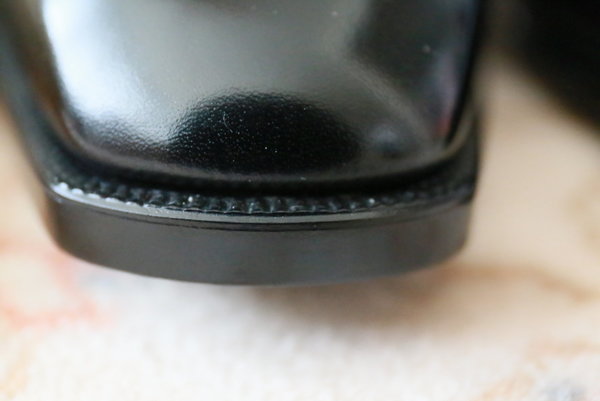jerrybrowne
Distinguished Member
- Joined
- Jul 29, 2009
- Messages
- 2,929
- Reaction score
- 647
Thanks Nicholas! Sounds exciting. Yes, getting back into the swing of things. When are you back in Boston? Have some ideas for new things we can work on.
STYLE. COMMUNITY. GREAT CLOTHING.
Bored of counting likes on social networks? At Styleforum, you’ll find rousing discussions that go beyond strings of emojis.
Click Here to join Styleforum's thousands of style enthusiasts today!
Styleforum is supported in part by commission earning affiliate links sitewide. Please support us by using them. You may learn more here.
nick, can your guy do pie crust with cordovan leather too?Great to see you back jerrybrowne, it’s always been a pleasure to make for you! I’ve actually got that belated replacement pair under way for you at the moment - found a guy who does that pie crust stitch and sourced the right leather to match 88 aniline. I’ll keep you posted
how did it come out? is this the same guy that does the cordovan pie crust for ascot/chu?He did it once and wasn’t very happy about it. I wouldn’t be very happy about offering it, either
just because it can be done doesn’t mean it should
I’ve had this in my mind for a while now and I’ve been consciously trying to stumble upon earlier examples from paintings where heels could be found early 16th century and prior. Today I was at a museum, a couple actually and I still had this in mind. It really seems you’re correct and I find it fascinating. Where did the heel begin? Was it functional? (Stirrups, lift out of the mud) or aesthetic? (Lengthen the leg, add height)Here's another nugget for you to ponder--heels...as we know them...do not appear until the late 16th century. No records, no paintings, no descriptions exist to support heels...as we know them...before that time.
I’ve had this in my mind for a while now and I’ve been consciously trying to stumble upon earlier examples from paintings where heels could be found early 16th century and prior. Today I was at a museum, a couple actually and I still had this in mind. It really seems you’re correct and I find it fascinating. Where did the heel begin? Was it functional? (Stirrups, lift out of the mud) or aesthetic? (Lengthen the leg, add height)







 LuxeSwap Auction - Vintage Antique United States Naval Navy Denim Deck Jacket A piece for denim heads, vintage collectors, streetwear enthusiasts and menswear enthusiasts alike, this extremely rare early US Naval issued deck jacket in raw denim is not likely to ever show up at auction again anytime soon. A Haleys Comet of menswear items, offered at auction at a $9.99 starting bid with no reserve.
LuxeSwap Auction - Vintage Antique United States Naval Navy Denim Deck Jacket A piece for denim heads, vintage collectors, streetwear enthusiasts and menswear enthusiasts alike, this extremely rare early US Naval issued deck jacket in raw denim is not likely to ever show up at auction again anytime soon. A Haleys Comet of menswear items, offered at auction at a $9.99 starting bid with no reserve.  Kirby Allison - Luxury Suit Hanger - $32 Kirby Allison's Luxury Wooden Suit Hangers protect your suits from stretched collars and droopy shoulders. Our wooden suit hangers provide five-times more support than average hangers and will protect and extend the life of your most important garments.
Kirby Allison - Luxury Suit Hanger - $32 Kirby Allison's Luxury Wooden Suit Hangers protect your suits from stretched collars and droopy shoulders. Our wooden suit hangers provide five-times more support than average hangers and will protect and extend the life of your most important garments.  LuxeSwap Auction - Vintage Antique United States Naval Navy Denim Deck Jacket
A piece for denim heads, vintage collectors, streetwear enthusiasts and menswear enthusiasts alike, this extremely rare early US Naval issued deck jacket in raw denim is not likely to ever show up at auction again anytime soon. A Haleys Comet of menswear items, offered at auction at a $9.99 starting bid with no reserve.
LuxeSwap Auction - Vintage Antique United States Naval Navy Denim Deck Jacket
A piece for denim heads, vintage collectors, streetwear enthusiasts and menswear enthusiasts alike, this extremely rare early US Naval issued deck jacket in raw denim is not likely to ever show up at auction again anytime soon. A Haleys Comet of menswear items, offered at auction at a $9.99 starting bid with no reserve.
 Wellington Chore Boot - Special Introductory Price! $495
Introducing the latest addition to Nicks Handmade Boots collection: The Wellington Chore Boot. Engineered for the rigors of daily tasks, this boot is more than just footwear; it's a reliable companion for your everyday adventures. Crafted with convenience in mind, its effortless pull-on design ensures you're always ready to tackle whatever the day throws your way.
Wellington Chore Boot - Special Introductory Price! $495
Introducing the latest addition to Nicks Handmade Boots collection: The Wellington Chore Boot. Engineered for the rigors of daily tasks, this boot is more than just footwear; it's a reliable companion for your everyday adventures. Crafted with convenience in mind, its effortless pull-on design ensures you're always ready to tackle whatever the day throws your way.